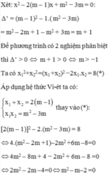Hãy nhập câu hỏi của bạn vào đây, nếu là tài khoản VIP, bạn sẽ được ưu tiên trả lời.

\(\Delta=9-4\left(-m^2+m+2\right)=4m^2-4m+1=\left(2m-1\right)^2\)
Pt có 2 nghiệm pb khi \(m\ne\dfrac{1}{2}\)
Do vai trò của 2 nghiệm là như nhau, giả sử: \(\left\{{}\begin{matrix}x_1=\dfrac{3-\left(2m-1\right)}{2}=2-m\\x_2=\dfrac{3+2m-1}{2}=m+1\end{matrix}\right.\)
\(x_1^2+x_2^2=5\Leftrightarrow\left(2-m\right)^2+\left(m+1\right)^2=5\)
\(\Leftrightarrow m^2-m=0\Rightarrow\left[{}\begin{matrix}m=0\\m=1\end{matrix}\right.\)

\(x^3-5x^2+2mx+5x-4m+2=0\)
\(\Leftrightarrow\left(x^3-5x^2+5x+2\right)+2m\left(x-2\right)=0\)
\(\Leftrightarrow\left(x-2\right)\left(x^2-3x-1\right)+2m\left(x-2\right)=0\)
\(\Leftrightarrow\left(x-2\right)\left(x^2-3x+2m-1\right)=0\)
\(\Leftrightarrow\left[{}\begin{matrix}x=2\\x^2-3x+2m-1=0\left(1\right)\end{matrix}\right.\)
a. Pt đã cho có 3 nghiệm pb khi và chỉ khi (1) có 2 nghiệm pb khác 2
\(\Leftrightarrow\left\{{}\begin{matrix}4-6+2m-1\ne0\\\Delta=9-4\left(2m-1\right)>0\end{matrix}\right.\) \(\Leftrightarrow\left\{{}\begin{matrix}m\ne\dfrac{3}{2}\\m< \dfrac{13}{8}\end{matrix}\right.\)
b. Do vai trò 3 nghiệm như nhau, không mất tính tổng quát, giả sử \(x_1;x_2\) là nghiệm của (1) và \(x_3=2\)
Theo hệ thức Viet: \(\left\{{}\begin{matrix}x_1+x_2=3\\x_1x_2=2m-1\end{matrix}\right.\)
\(x_1^2+x_2^2+x_3^2=11\)
\(\Leftrightarrow\left(x_1+x_2\right)^2-2x_1x_2+4=11\)
\(\Leftrightarrow9-2\left(2m-1\right)-7=0\)
\(\Leftrightarrow m=1\)

a) Có: `\Delta'=(m-2)^2-(m^2-4m)=m^2-4m+4-m^2+4m=4>0 forall m`
`=>` PT luôn có 2 nghiệm phân biệt với mọi `m`.
b) Viet: `x_1+x_2=-2m+4`
`x_1x_2=m^2-4m`
`3/(x_1) + x_2=3/(x_2)+x_1`
`<=> 3x_2+x_1x_2^2=3x_1+x_1^2 x_2`
`<=> 3(x_1-x_2)+x_1x_2(x_1-x_2)=0`
`<=>(x_1-x_2).(3+x_1x_2)=0`
`<=> \sqrt((x_1+x_2)^2-4x_1x_2) .(3+x_1x_2)=0`
`<=> \sqrt((-2m+4)^2-4(m^2-4m)) .(3+m^2-4m)=0`
`<=> 4.(3+m^2-4m)=0`
`<=> m^2-4m+3=0`
`<=>` \(\left[{}\begin{matrix}m=3\\m=1\end{matrix}\right.\)
Vậy `m \in {1;3}`.

\(\Delta'=\left[-\left(m+1\right)^2\right]-\left(m^2-1\right)\\ =m^2+2m+1-m^2+1\\ =2m+2\)
Để PT có 2 nghiệm phân biệt thì: \(\Delta'>0\)
\(\Leftrightarrow2m+2>0\\\Leftrightarrow2m>-2\\ \Leftrightarrow m>-1 \)
Theo vi ét có: \(\left\{{}\begin{matrix}x_1+x_2=\dfrac{-b}{a}=\dfrac{2\left(m+1\right)}{1}=2m+2\\x_1x_2=\dfrac{c}{a}=m^2-1\end{matrix}\right.\)
Theo đề có:
\(x_1^2+x_2^2=x_1x_2+8\\ \Leftrightarrow x_1^2+x_2^2-x_1x_2-8=0\\ \Leftrightarrow x_1^2+x_2^2+2x_1x_2-x_1x_2-2x_1x_2-8=0\\ \Leftrightarrow\left(x_1+x_2\right)^2-3x_1x_2-8=0\\ \Leftrightarrow\left(2m+2\right)^2-3\left(m^2-1\right)-8=0\\ \Leftrightarrow4m^2+8m+4-3m^2+3-8\\ \Leftrightarrow m^2+8m-1=0 \)
\(\Delta=8^2-4.-1=64+4=68\) > 0
\(\Rightarrow m_1=\dfrac{-8+\sqrt{68}}{2}=-4+\sqrt{17}\left(nhận\right)\)
\(m_2=\dfrac{-8-\sqrt{68}}{2}=-4-\sqrt{17}\left(loại\right)\)
Vậy để phương trình có hai nghiệm phân biệt thỏa mãn x12 + x22 = x1x2 +8 thì m có giá trị là \(-4+\sqrt{17}\)
$HaNa$
Δ=(2m+2)^2-4(m^2-1)
=4m^2+8m+4-4m^2+4=8m+8
Để phương trình có hai nghiệm phân biệt thì 8m+8>0
=>m>-1
x1^2+x2^2=x1x2+8
=>(x1+x2)^2-2x1x2-x1x2=8
=>(2m+2)^2-3(m^2-1)-8=0
=>4m^2+8m+4-3m^2+3-8=0
=>m^2+8m-1=0
=>m=-4+căn 17(nhận) hoặc m=-4-căn 17(loại)

a,để pt có nghiệm kép
\(\Delta=m^2-\left(m^2-m+1\right)=m-1=0\Leftrightarrow m=1\)
\(x_1=x_2=\dfrac{2m}{2}=m=1\)
b, để pt có nghiệm \(m\ge1\)
c, Ta có \(\left(x_1+x_2\right)^2-4x_1x_2=6\)
Thay vào ta đc \(4m^2-4\left(m^2-m+1\right)=6\)
\(\Leftrightarrow4m=10\Leftrightarrow m=\dfrac{5}{2}\left(tm\right)\)

1.Ta có \(\Delta=4m^2-4\left(m^2-m-3\right)=4m+12\)
Để phương trình có 2 nghiệm phân biệt \(\Rightarrow\Delta>0\Rightarrow4m+12>0\Rightarrow m>-3\)
Theo hệ thức Viet ta có \(\hept{\begin{cases}x_1+x_2=2m\\x_1.x_2=m^2-m-3\end{cases}}\)
a. Phương trình có 2 nghiệm trái dấu \(\Rightarrow x_1.x_2< 0\Rightarrow m^2-m-3< 0\Rightarrow\frac{1-\sqrt{13}}{2}< m< \frac{1+\sqrt{13}}{2}\)
Vậy \(\frac{1-\sqrt{13}}{2}< m< \frac{1+\sqrt{13}}{2}\)
b. Phương trình có 2 nghiệm phân biệt dương \(\Leftrightarrow\hept{\begin{cases}x_1+x_2=2m>0\\x_1.x_2=m^2-m-3>0\end{cases}\Leftrightarrow\hept{\begin{cases}m>0\\m< \frac{1-\sqrt{13}}{2}\end{cases}\left(l\right);\hept{\begin{cases}m>0\\m>\frac{1+\sqrt{13}}{2}\end{cases}\Leftrightarrow m>\frac{1+\sqrt{13}}{2}}}}\)
Vậy \(m>\frac{1+\sqrt{13}}{2}\)
2. a.Ta có \(\Delta=\left(2m-1\right)^2+4m=4m^2-4m+1+4m=4m^2+1\)
Ta thấy \(\Delta=4m^2+1>0\forall m\)
Vậy phương trình luôn có 2 nghiejm phân biệt với mọi m
b. Theo hệ thức Viet ta có \(\hept{\begin{cases}x_1+x_2=1-2m\\x_1.x_2=-m\end{cases}}\)
Để \(x_1-x_2=1\Leftrightarrow\left(x_1-x_2\right)^2=1\Leftrightarrow\left(x_1+x2\right)^2-4x_1x_2=1\)
\(\Leftrightarrow\left(1-2m\right)^2-4.\left(-m\right)=1\Leftrightarrow4m^2-4m+1+4m=1\)
\(\Leftrightarrow m^2=0\Leftrightarrow m=0\)
Vậy \(m=0\)thoă mãn yêu cầu bài toán

a)Ta có:
`\Delta'`
`=(m+1)^2-6m+4`
`=m^2+2m+1-6m+4`
`=m^2-4m+5`
`=(m-2)^2+1>=1>0(AA m)`
`=>`phương trình (1) luôn có 2 nghiệm phân biệt với mọi m
Câu b đề không rõ :v

a) \(\Delta=\left[-\left(m+3\right)\right]^2-4.1.m\\ =m^2+6m+9-4m\\ =m^2+2m+9\\ =\left(m+1\right)^2+8>0\forall m\)
Vậy phương trình luôn có 2 nghiệm phân biệt với mọi m.
b) Áp dụng hệ thức Vi-et, ta có:
\(\left\{{}\begin{matrix}x_1+x_2=m+3\\x_1x_2=m\end{matrix}\right.\)
Mà \(x_1^2+x_2^2=6\)
\(\Leftrightarrow\left(x_1+x_2\right)^2-2x_1x_2=6\\ \Leftrightarrow\left(m+3\right)^2-2m=6\\ \Leftrightarrow m^2+6m+9-2m=6\\ \Leftrightarrow m^2+4m+3=0\\ \Leftrightarrow\left(m+1\right)\left(m+3\right)=0\\ \Leftrightarrow\left[{}\begin{matrix}m=-1\\m=-3\end{matrix}\right.\)
Vậy \(m\in\left\{-1;-3\right\}\) là các giá trị cần tìm.
a, Ta có: \(\Delta=\left[-\left(m+3\right)\right]^2-4.1.m\)
\(=m^2+6m+9-4m\)
\(=m^2+2m+9\)
\(=m^2+2m+1+8\)
\(=\left(m+1\right)^2+8\)
Lại có: \(\left(m+1\right)^2\ge0\forall m\Rightarrow\left(m+1\right)^2+8\ge8\forall m\)
Vậy phương trình luôn có 2 nghiêm phân biệt
b, Theo hệ thức Vi-ét: \(\left\{{}\begin{matrix}x_1+x_2=m+3\\x_1+x_2=m\end{matrix}\right.\)
Theo bài ra:
\(x_1^2+x_2^2=6\)
\(\Leftrightarrow\left(x_1+x_2\right)^2-2x_1x_2=6\)
\(\Leftrightarrow\left(m+3\right)^2-2m=6\)
\(\Leftrightarrow m^2+6m+9-2m=6\)
\(\Leftrightarrow m^2+6m+9-2m-6=0\)
\(\Leftrightarrow m^2+4m+3=0\)
\(\Leftrightarrow m^2+m+3m+3=0\)
\(\Leftrightarrow\left(m^2+m\right)+\left(3m+3\right)=0\)
\(\Leftrightarrow m\left(m+1\right)+3\left(m+1\right)=0\)
\(\Leftrightarrow\left(m+1\right)\left(m+3\right)=0\)
\(\Leftrightarrow\left[{}\begin{matrix}m+1=0\\m+3=0\end{matrix}\right.\)
\(\Leftrightarrow\left[{}\begin{matrix}m=-1\\m=-3\end{matrix}\right.\)
Vậy với m=-1 hoặc m=-3 thì phương trinh trên thỏa mãn hệ thức

